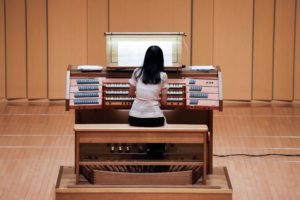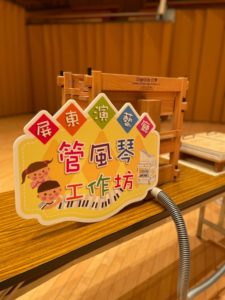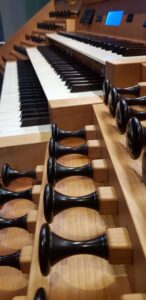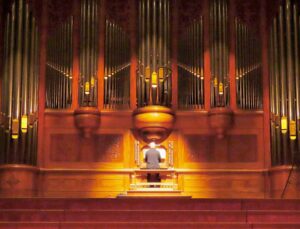Orgelkids China執行長蔣士挺(Justin Berg)「兒童管風琴教育專欄」【初因初音】(My First Sound)。 "Making Itself Heard: The Many Voices of the Organ" from the column【My First Sound】 by Justin Berg, the Executive Director of Orgelkids China. (In English below)
離開荷蘭、跨越海峽後,我們也會在英國看到加倍音管的管列,但是與荷蘭的管風琴有一個重大的差別:英國管風琴把整個基礎音栓的管列都做成加倍,而不是只有高音部音區;並且,這些管列都有各自的拉鈕式音栓把手,而荷蘭管風琴的加倍音栓組合是以單一拉鈕把手控制的。我們也注意到,英國的教堂可能也是又大又深,但裡面的管風琴起初並不是設置在教堂西側的迴廊高處(在低地國、德國、法國才是)。英國的管風琴有時候座落在一道牆(或稱聖壇屏幕)的頂上 (附圖1),這道牆就是教堂內最長的部分(中殿)與靠近祭壇的較小區域(詩班和聖壇)的分隔。座落在這個屏幕頂上的管風琴,距離教堂中心大約是三分之一的位置,可以從屏幕兩側看到管風琴 (附圖2),所以外殼不能有背板,必須有兩個正面,一面朝東、一面朝西 (附圖3)。這或許就是加倍基礎音栓的起源(現今仍有一些管風琴繼續使用),因為需要有兩組基礎音栓,外殼才會有兩個正面。無論這些彼此相對的管列存在的原因是什麼,結果就是這些加倍管列可以同時向兩個方向發出聲音,製造出立體音效來充滿教堂內部。
我們再次返回歐陸,來到北歐和德國,這些地方(例如今天的瑞典和德國)的小教堂往往天花板比較低 (附圖4),在歐洲北部極冷的冬季,或許會讓室溫稍微暖和一點,但也導致這些教堂無法像石造大教堂那樣製造出轟隆隆的音響效果,尤其是在木造建築物裡,這個情形導致音響效果很乾,低音很快便被吸收掉。或許這可以解釋為什麼腳鍵盤在北方國家有更大規模的發展而形成自己的音栓。或許大型腳鍵盤區的設計,就是為了彌補這些空間裡所喪失的低音。當然,德國管風琴發展出腳鍵盤還有別種重要的原因,但這個考量可能就是原因之一。無論如何,我們會聽到大型的腳鍵盤區,包括多個16呎音栓,有的甚至有32呎音栓;有些音管會比標示出的音高再低兩個八度,這些威力十足的低音讓德國管風琴能將深厚的聲音充滿室內空間 (附圖5)。
比較起來,法國的建造者則發明完全不同的方法來把聲音填滿大型空間。在17世紀末,他們發現火熱的簧管可提升管風琴聲音的優雅和激昂。從古典時期一直到現在,法國各地的管風琴都會有簧管添加在管風琴的各種音區,尤其是標準長度的8呎小號,還有更高音的4呎小號。我們確實會在各個音區裡看到這些,包含主琴的主音管群和腳鍵盤;而到了18世紀,甚至可以發現它們充滿在小風琴和增風琴。看起來,製造出這一系列小號音栓之後,合理的下一步應該就是開始加倍這些管列,例如18世紀晚期最大的管風琴,單是主音管群就擁有兩個8呎長的小號音管和兩個4呎小號音管。但是在出現加倍管列之前,法國的管風琴建造家就已經找到一些方法,讓簧管發出激昂的聲音而無法與基礎音栓和混合音管結合,如同比較北邊的管風琴。但這個情況在19世紀已有改變,因為更大的風壓和嶄新的設計使簧管能夠加入笛管家族的行列。(待續)
Making Itself Heard: The Many Voices of the Organ (part2)
“Making Itself Heard: The Many Voices of the Organ” (part2)
Departing Holland and crossing the channel, we also find organs in England with doubled ranks. But! There is an important difference between these organs and their Dutch cousins: the English organs double entire ranks of Diapasons, instead of only the trebles, and these ranks also have individual draw knobs. In the Dutch organs, doubled trebles were controlled by a single drawknob. We notice that English churches can also be cavernous, but we see that organs in those churches were not initially placed high in a gallery at the west end of the church, as was often true throughout the Low Countries, Germany and France. Instead, English organs sometimes sat, perched on top of the wall, or ‘screen’, that divided the longest part of the building (the nave) from the smaller area near the altar (the choir and sanctuary). An organ sitting on top of this screen was positioned about one third of the way down the center of the building. Since such organs could be seen from both sides of the screen, their cases could not have a back; rather, they had to have two façades, one facing East and the other West. This was likely the origin of doubled Diapason ranks — which continue to be used in some organs today — as two diapasons were needed to create the two fronts of the case. Whatever other reasons may have existed for these opposite-facing ranks, the result was that such doubled ranks could speak in two different directions at the same time, creating a kind of stereo effect that filled the church.
Crossing back to Continental Europe, we travel to the northern Scandinavian and German lands. In those places, like present-day Sweden and Germany, smaller churches often had relatively low ceilings, may have helped to keep these rooms somewhat warmer during the extremely cold winter months in northern Europe. But the lower height also prevented these churches from having the large, rolling acoustics of a stone cathedral. As a result of this, and particularly in places with wooden buildings, we only hear very dry acoustics that tend to absorb bass sounds quickly. Perhaps this helps to explain why the pedalboard developed more extensively in northern countries, complete with its own stops. Maybe large pedal divisions were designed to compensate for the loss of bass sounds in drier rooms. Of course, there are other important reasons for the development of the Germanic pedal division, but this just might have been one contribution to that development. At any rate, we hear large pedal divisions including multiple 16’ stops and even sometimes 32’ stops, or pipes that sounded two octaves lower than their written pitch. All that powerful bass allowed the Germanic organs to fill rooms with a great depth of sound.
By contrast, French builders discovered a wholly different means of filling large rooms. By the 17th century, they had discovered the brilliance that fiery reeds could heighten the elegance and excitement of the organ’s sound. Listening to organs throughout France, from the Classical era to the present, we hear reeds added to all divisions of the organ, including most especially the full-length 8’ Trompette and its higher neighbor, the 4’ Clairon. Indeed, we find these in multiple divisions, including the Grand Orgue and Pedal, and by the 18th century we even discover them populating the Positif and Récit divisions. It seems that the next logical step after building such batteries of trompette stops was to begin duplicating those ranks, such that the largest late-18th century instruments boasted two 8’ Trompettes and two 4’ Clairon on the Grand Orgue alone. Even before such duplication began, though, French builders had found ways of making their reeds so intense that they could not be combined with principal and mixture ranks, as was the case in organs further north. This situation changed in the 19th century, however, as higher wind pressures and new designs permitted the reeds to rejoin the flue pipes. (To be continued)
Your Friend,
Justin





